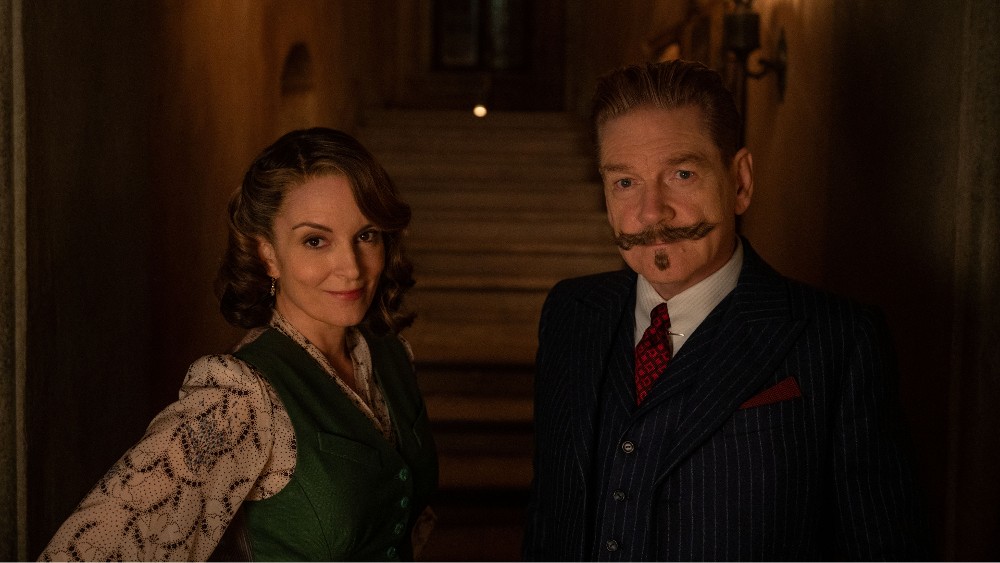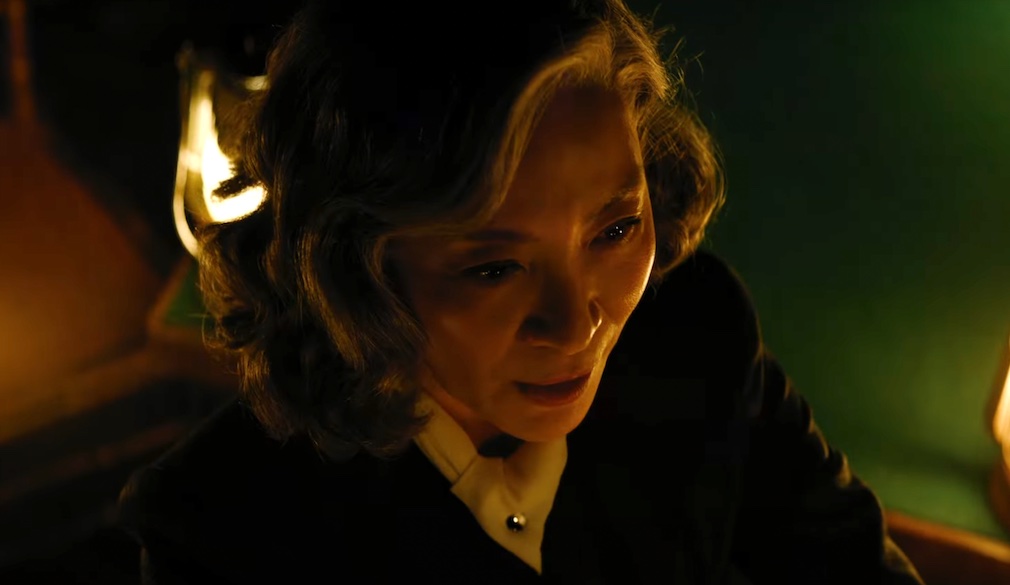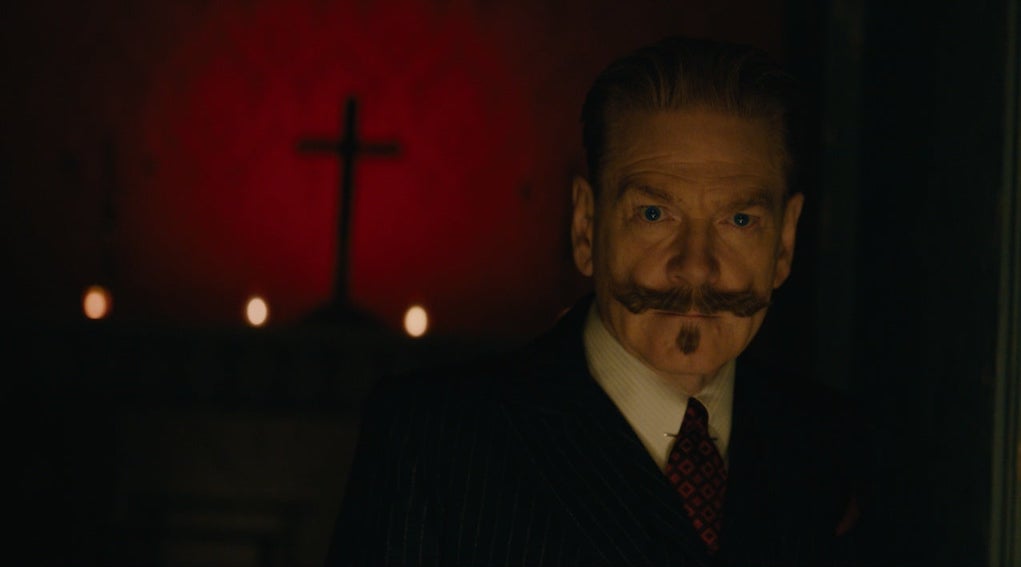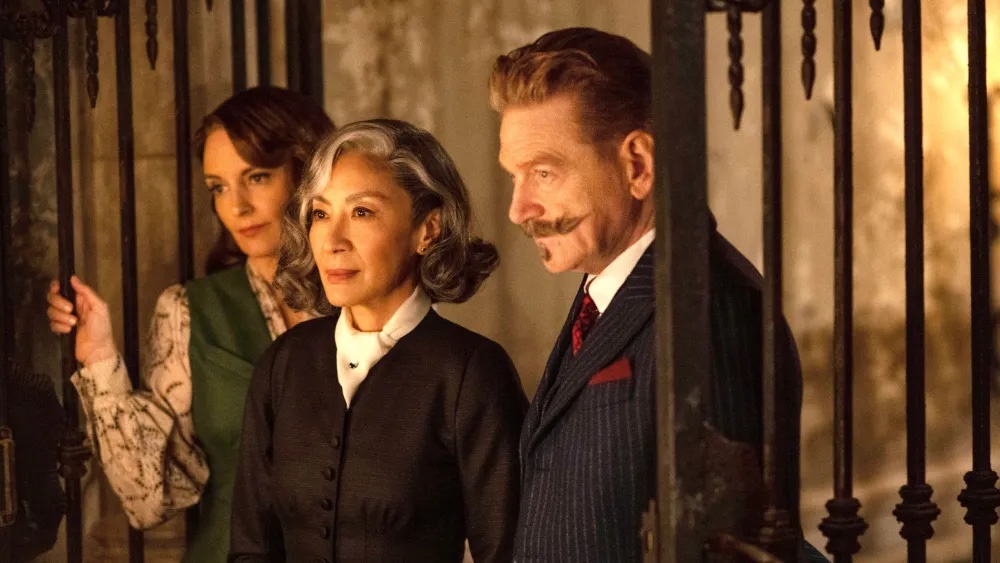
There’s serving the filmmaker, and there’s serving the audiences. Sometimes these two tasks meet in the middle; sometimes they don’t. In the case of A Haunting in Venice, editor Lucy Donaldson brings both the storyteller and the viewer together with a murder mystery that’s lean, mean, and a pure gothic spectacle.
The latest Agatha Christie adaptation is about the audience just as much as it’s about their eyes and ears in this story, Detective Hercule Poirot (played by Kenneth Branagh, who, as a filmmaker, relishes all five senses of Poirot). The famous detective is retired in a Post-World War II Venice, where one or two characters die over Halloween. It’s up to Poirot, in a lavish house with secrets, to rediscover his curiosity about the world as well as uncover the identity of the murderer or murderers.
It’s dynamite B-movie stuff that’s played as A-movie drama. Together, Branagh and Donaldson’s work produce both eye and mind candy. In a brisk 100 minutes or so, Donaldson serves the audience, ensemble, and filmmaker. It’s a magic that Poirot himself would question.
Below the Line spoke with Donaldson about crafting A Haunting in Venice and why she values the test screening process.
[Note: This interview has been edited for clarity and length]
Below-The-Line: Seeing this movie in IMAX is very satisfying.
Lucy Donaldson: So nice to hear. Thank you for saying that. Yeah, the IMAX is something else. I’m delighted it’s getting an IMAX release.
BTL: In that format, do you find the pacing or feel of a movie changes? Would you cut differently for IMAX?
Donaldson: I saw it in IMAX as well, and it is a slightly different experience because you’re just so much into the movie. I mean, I wouldn’t change anything, but yes, it felt slightly different. It is hard to put my finger on, but it just felt like a slightly different experience.
One of the things that I like about it, an adventurous choice, is having these mega-wide shots and the close-ups. It was one of the many style choices that were made to challenge the audience, do something different, do something that isn’t always comfortable. So for that reason alone, it was fun because it was like, “Oh, right, okay, let’s get into this. We didn’t play it safe.”
BTL: In those wide shots, it’s very theatrical yet cinematic. The same balance goes for the performances. For example, Michelle Yeoh crying as she looks so steadfast and strong. Do you get a lot of options to play with for the performances?
Donaldson: Absolutely. With actors of that caliber, we had a lot of choices. Funnily enough, in that scene, I cut it the first time Michelle doesn’t get emotional because I liked her being completely in control and playing with Poirot more. It was Ken who said, “Let’s have a look at it with the more emotional takes.” The effect of that makes you think, “Oh God, where is she coming from? Is that genuine or is that not genuine?” She’s wonderful, got the role, and played that [question] down the line very well of, who is she?
I think a more general aim is to walk the line of a lot of tones. So the lighter and the darker, and the question of, is there anything beyond what we can see and touch? We didn’t want to come down on either side, but the fun was putting someone like Poirot, who’s such a skeptic, into that environment. That was where the tension and the fun of it was.

BTL: As far as the tone goes, there’s the horror, but there’s also a screwball comedy happening between Kenneth Branagh and Tina Fey. How far did you want to push the jokes?
Donaldson: Tina again gave us loads of choices. It’s funny, we changed the emphasis a couple of times. Originally, I cut the funniest takes because we did a round where it was much more about post-war. Poirot is really doubting himself. And so, we took out some of the comedy, and then we ended up putting most of it back because I think there are some themes and some scenes that are very sad. It was so evident on set that they were enjoying each other, the banter was genuine, and there was a lot of ad-libbing. There was a lot more of it, so it was quite hard to pare it down.
BTL: The movie is extremely lean. Not an ounce of fat, just pure meat and potatoes storytelling.
Donaldson: Oh, thanks. That’s nice to hear too. I mean, in some ways, I like really sitting with a film and being patient, and it’s hard because it is a story that we really hope has broad appeal, so… you can’t please everybody. It would’ve been nice in some ways to linger more, but we made the choice of keeping people on their toes, and there are scenes that are sort of sad, and then we go straight into a different tone. I think overall, it’s more fun, especially in a story like this, to keep the audience on their toes as much as possible.
BTL: How was juggling all the tones? You do have a talking bird for comedic effect.
Donaldson: Well, I’ll tell you a secret. I am actually the voice of the talking bird [laughs].
BTL: [laughs] Congratulations. You scored a big laugh.
Donaldson: [laughs] I don’t know if I’m offended at that laugh.
BTL: [laughs] How’d you land that role?
Donaldson: I was cutting dailies, and I needed that bird to speak, and nobody else would do it. So I was like, alright. The sound team was like, “No, no, no, we’ll get professionals in.” None of it was sort of landing. So I was like, oh, we couldn’t get anybody to do it better.
I did actually re-record it because the bird originally said something different. But by that point, I had owned the role, Harry, he’s called. There’s a particularly great shot after the first death, and we just cut to his big eye. I’d always thought that that was, Harry’s been here for a long time and he’s seen a lot.
BTL: Did your experience with past horror movies, especially horror comedies, come in handy on A Haunting in Venice?
Donaldson: It certainly did help the experience. I worked at Blumhouse many times on many different projects and got to know that line between being scared and laughing. I think that moment of Harry speaking gets a laugh hopefully, because there was tension before and it’s that kind of release. When I get scared, I do find myself laughing, and it’s just a very weird feeling of that sort of roller coaster ride. I enjoy building atmospheres, having things feel just a bit off-kilter, surprising people.

BTL: Did you and Kenneth Branagh ever talk about Hammer horror movies? I thought of a few here.
Donaldson: Oh, funny. I watched a few of those when I was far too young a child. We talked more about the noir influences. I know he is a big Barbara Stanwick fan and those sorts of films. There’s a James Whale film called The Old Dark House, which is good at very simply telling a scary house story. So, there are lots of influences.
One of the films that the script reminded me of was another film set in Venice, Don’t Look Now, which I love. Also, Death in Venice is pretty icky in a few ways, but it’s set during a time when they’re having some sort of outbreak. People keep getting sick, but all the hoteliers want to hide that fact. They want to keep business good, and it’s really like, this is a beautiful place, and then there’s the sickness. I enjoy those contrasts.
BTL: I’ll have to check that film out. There are a lot of close-ups in this movie. It fits since it’s about how we see the world. Did you and Kenneth talk a lot about enhancing themes in the editing room?
Donaldson: No, but I like that point. We talked more about each character having their secret sadness. So, we put all these characters into a situation. Some of them hate each other, and most of ’em are strangers to each other. Some have a history with each other, but through this turn of events, Poroit gets to know what’s going on with them. We worked quite a lot getting the nuance that we wanted.
We didn’t have many mid-shots, to be honest. I’m sure that was a choice because we wanted to be with the characters experiencing it. Certainly, with the seance, there are a lot of interesting shots, but we stayed in, again, these very wides and the close-ups and really trying to build this atmosphere of what’s going on. Some of the characters are very hostile during the seance, and some of them are signed up, so there were a lot of plot points in that scene. It’s not a short scene.
With great actors, they give you the sorts of expressions that you can use in lots of different ways. I just love actors. I just love studying faces, and there’s something that’s happening. It is weird talking about editing. There’s something that happens, it’s not quite subconscious, but it’s quite deeply in the back of the mind. I think it’s a language or something having watched and digested films all my life.
It’s only when you’re working with the director that you’re just like, “Why did I put those two shots together? What was it?” And then you can talk about it. Kenneth is ruthless in shaping the whole, so he doesn’t get attached to certain things. If it’s not as strong as other material, he will lift it out. It’s all about the whole organism. How does it serve the story? What do we want the audience to know at this point about this character or this plot point?
Especially with Agatha Christie, there are clues that we want to say we showed you if you didn’t see it. We want to give the audience a chance, but without making it obvious, that is really the work. After we’d shown early audiences, we made changes based on those comments of the number of times that people cottoned on to what was going on and at what point. So it’s just constantly going over and over.

BTL: What’s your relationship with an audience during the testing phase? Can they ever be wrong in your mind?
Donaldson: It’s so useful to show an audience, especially having that experience of people laughing where you’re like, “I didn’t know that was funny.” It’s great. A laugh is 90% of the time always a good thing, and you can’t disagree with an audience. The thing is, it’s all about, especially as an editor, remaining objective.
I did go to set, and just talk to Ken a couple of times, but I wasn’t on set when they were setting up shots or filming because it’s that thing of… I’m the first audience, so whatever they shot is what they shot, not what they intended to shoot. But even so, you lose your objectivity as you go.
I think sometimes what happens is you become so familiar with it, you think certain things are obvious or you don’t find this funny anymore. So, it mustn’t be funny, right? But I’ve seen it a bazillion times, very few things that are funny that often.
I think it would be a real disservice to say that the audience is wrong because the audience is made up of so many disparate people and people have sensitivities, and during the previews, people fill out cards, and they’re really interesting to read, and people come from all sorts of angles as well in terms of what they want.
BTL: You read the cards?
Donaldson: Oh yeah.
BTL: Any that stand out to you in particular?
Donaldson: There is one, but I don’t want to say it because it’s a bit of a spoiler. Yeah, it’s just always nice because you always feel, how will this land with an audience? And we’re making it for an audience. So yeah, it’s a great process to go through.
BTL: Where did you personally wish to linger more?
Donaldson: Well, the first sequence of Venice, as you can imagine, we had a lot of lovely material. The whole first section of the film before we get to the Palazzo, it used to be a lot longer. And then when we were in the canals with the people in Venice, in period costumes, that was fun.
There’s a deleted scene where Poirot goes to the Doge’s palace and looks at the Tintoretto painting. The visuals are stunning, absolutely stunning. It was Poirot in Venice, this was his typical day, and this is who he is now. And then as quickly as possible, it had to be interrupted by Ariadne Oliver’s (Tina Fey) arrival where she really shakes him up. It’s like, “This is pathetic. You need to get on with your life, and you are coming with me.”
We had much more material with that party. I particularly like the scene with Joyce Reynolds (Yeoh) and Ariadne sparring. Joyce Reynolds says to her, “Ariadne Oliver, my nemesis,” and there’s a really great look. That was the first scene that I just thought, “Oh, I love this.” I mean, there was lots of it that I laughed, but I was like, “Oh, this I love.” There were so many looks and jabs, and that scene was a bit longer as well.
But the shooting was very efficient. It wasn’t one of those films that we discarded an unusual amount of material. Of course, we sort of honed it down. The editor’s cut was, I think, two hours, and 45 minutes. We took a whole hour out.
BTL: Did it play well?
Donaldson: Well, I thought so, but I really needed to go to the bathroom afterward [laughs]. But the other thing was, I really liked this, but I didn’t cut with music for a long time at Ken’s request. He’s like, “No temp music.” We did that because that way we could really find the rhythm of the material, because once you put music in, it will always elevate it, but it also sets a tone a bit. It can set the tone too early or set the rhythm too early.
I think it’s a testament to what Ken shot, that it certainly kept your interest for almost three hours. The other reason we did that was there’s a theme in the film about listening and the environment, which goes back to the question about genre. And so, it was really interesting to use sound work more to create the environment, and this house has secrets, and is there anything there that is not human? And it was good to have a musicless cut for a while to see where we could play with that.
A Haunting in Venice is now playing in theaters.





